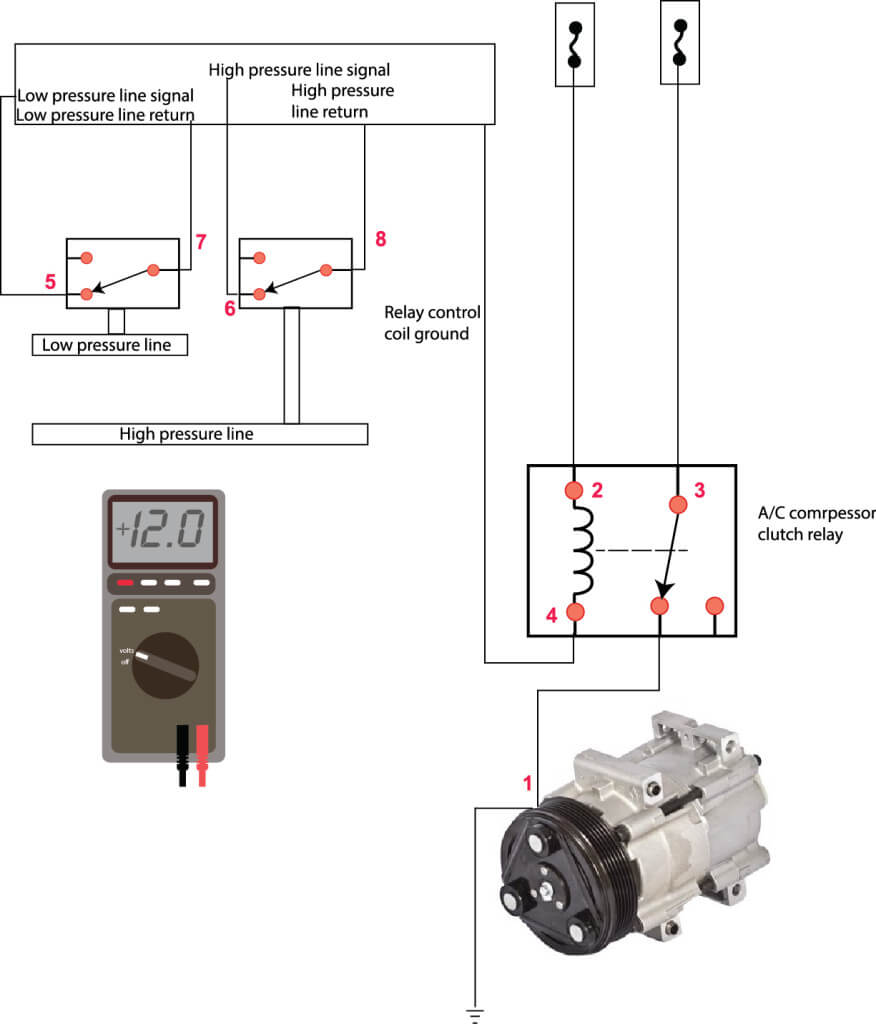AC compressor won’t run
Why doesn’t my car AC compressor run?
If the A/C in your car isn’t working, the first step is to see if the compressor runs when the turn on the A/C and the engine. If you discover an AC compressor won’t run situation, follow these diagnostic steps to find out what’s wrong. You’ll need a digital multimeter and a wiring diagram or parts locator to find the high and low pressure switches.
The wiring diagram I show here is a generic diagram. It’s similar in most ways to how auto A/C is wired. But some vehicles have different wiring schemes.

Check for power and ground at AC compressor clutch
Engine off. Disconnect the electrical connector at compressor clutch. Set meter at DC volts. Connect positive lead to one terminal in clutch electrical connector (1) , negative lead to battery ground. Start engine with A/C turned to max. Look for battery voltage on meter. If voltage is 0, move positive lead to the other terminal in electrical connector. If still 0, proceed to step 2.
If you see battery voltage on one terminal, leave the lead in that terminal and move the negative lead to the other terminal. If you see battery voltage with both leads connected to the electrical connector, that confirms the compressor clutch is getting power and ground. That means the clutch coil is bad. Some clutches are replaceable, others aren’t and you must replace the entire compressor.
Diagnose why there’s no power at compressor clutch
Find the compressor clutch relay and remove it from its socket. Connect the negative meter lead to battery negative terminal. Probe the relay socket terminals to detect battery power at terminals 2 & 3. If you don’t see battery voltage on both terminals, check the fuses and wiring to the relay. If you have battery power on both terminals, connect the positive lead to terminal 3 and the negative lead to terminal 4. You should see battery voltage. If you don’t, the PCM isn’t providing ground to the relay control coil, move to step 3.
For help in diagnosing a relay problem read this post on relay diagnostics.
Diagnose no ground at relay coil
The PCM will not provide ground to the compressor relay if the system is low on refrigerant or the pressure in the system is too high due to a blocked condenser, bad orifice tube or TMX valve. Locate the low pressure and high pressure switches. With meter still set on DC volts, disconnect the electrical connector at the low pressure switch. Connect the positive lead to one terminal and the negative lead to the other terminal. Start the engine and turn the A/C to max. Look for voltage on one of the two terminals (5). If you see volts, that means the PCM is providing power. Do the same test on the high pressure switch 5). Of power is present at both switches, conduct a continuity test across the switch contacts step 4
Check for continuity at pressure switches
With the meter set at ohms, connect one meter lead to one terminal (5) on the low pressure switch and the other lead to the other terminal (7) on the switch. If the switch is closed, the refrigerant level is good and you’ll get an ohms reading. If the pressure is too low, the switch will be open and you’ll get an infinite reading between 5 & 7. In that case, add refrigerant. Do NOT place a jumper across the low pressure switch in other to start the compressor. Refrigerant carries oil to lubricate the compressor. Running the compressor when it’s low on charge can starve the compressor of oil, destroying it in the process.
Repeat the test at the high pressure switch. With the meter set at ohms, connect one meter lead to one terminal (6) on the high pressure switch and the other lead to the other terminal (8) on the switch. If the switch is closed, the refrigerant pressure is good and you’ll get an ohms reading. If the pressure is too high, the switch will be open and you’ll get an infinite reading between 5 & 7. In that case, you have a serious restriction somewhere in the system and it must be serviced by a professional.
Clutch disc moves but won’t engage
The spacing between the compressor clutch disc and the pulley must be exact. This is referred to as the air gap. If the gap is too wide, the electromagnet won’t be able to pull the clutch disc in with enough force to mate with the pulley. The only way to diagnose compressor clutch air gap is with a feeler gap. See this post to learn more about AC compressor clutch air gap. This post also provides information on AC compressor clutches.
©, 2015 Rick Muscoplat
Posted on by Rick Muscoplat